
Calvert is a city in Robertson County, Texas, United States. As of the 2020 census, the city population was 962. It is located approximately halfway between Waco and Bryan-College Station at the intersection of Texas State Highway 6 and Farm to Market Roads 979 and 1644, on the Southern Pacific line, nine miles north of Hearne, in west central Robertson County. For the last 35 years, Calvert has enjoyed a relative success as an antique "capital". The town is named for Robert Calvert, an early settler who served in the Texas Legislature representing Robertson and Milam counties.
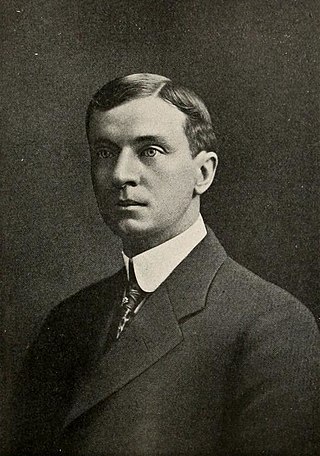
Edward Gardner Lewis was an American magazine publisher, land development promoter, and political activist. He was the founder of two planned communities that are now cities: University City, Missouri, and Atascadero, California. He created the American Woman's League (1907), a benefits fund for women who sold magazine subscriptions, as well as the American Woman's Republic (1911), a parallel organization designed to help women prepare themselves for a future in which they would have the right to vote. He also founded the People's University and its associated Art Academy in University City, as well as two daily newspapers and two banks.

The Texas Historical Commission is an agency dedicated to historic preservation within the U.S. state of Texas. It administers the National Register of Historic Places for sites in Texas.
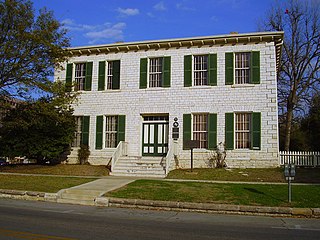
The Carrington–Covert House is a historic building in downtown Austin, Texas that serves as headquarters of the Texas Historical Commission. Built between 1855 and 1857, it is one of the few surviving pre-Civil War structures in the city.

George Julian Zolnay was a Romanian, Hungarian, and American sculptor called the "sculptor of the Confederacy".

The Llano County Courthouse and Jail were erected separately, but added to the National Register of Historic Places in Texas on December 2, 1977 as one entry. The courthouse, located in the middle of Llano's historic square, was built in 1893. The exterior is made of sandstone, marble, and granite. The interior of the courthouse was damaged by fire in 1932 and again in 1951. It is still in use today by local government. The jail was erected in 1895, with the prisoner cells on the second and third floors, and the ground level solely for the office and living accommodations for the sheriff and his family. The jail was designated a Recorded Texas Historic Landmark 1979, Marker 9448. The courthouse was designated a Recorded Texas Historic Landmark 1980, Marker number 9446.
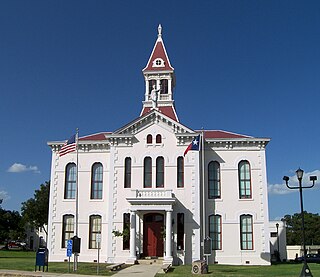
The Wilson County Courthouse and Jail are located in Floresville, Texas. They were added to the National Register of Historic Places in Texas in 1978 and the courthouse as a Recorded Texas Historic Landmark in 1984.

The Pioneer Memorial Library is located at 115 W. Main Street, Fredericksburg, Gillespie County, in the U.S. state of Texas. Designed by Alfred Giles, it was built in 1882 to replace the original 1855 courthouse, and was later superseded by the current 1939 courthouse designed by Edward Stein. The first floor houses the Children's Section, while the second floor houses the Adult Section, Texas Room, and newspapers and magazines. It is also called the McDermott Building because of the 1967 and 1984 restorations funded by Mr. & Mrs. Eugene McDermott. It was added to the National Register of Historic Places in 1971, and was designated a Recorded Texas Historic Landmark in 1967.

Alfred Giles was a British architect who emigrated to the United States in 1873 at the age of 20. Many of the private homes and public buildings designed by Giles are on the National Register of Historic Places and have been designated Recorded Texas Historic Landmarks. Based in San Antonio, his buildings can be found predominantly in south Texas and northern Mexico. Giles is credited with "a profound influence on architecture in San Antonio."
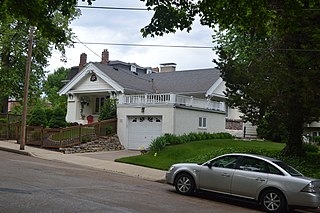
The Alton Chapter House is a historic building located at 509 Beacon St. in Alton, Illinois. The building was constructed between 1909 and 1910 as a meetinghouse for Alton's chapter of the American Woman's League. The American Woman's League was a political and social organization founded by magazine publisher Edward Gardner Lewis in 1908. The organization was created to promote feminist causes, particularly the women's suffrage movement; Lewis also intended for the organization to promote and sell his women's magazines. Lewis commissioned the St. Louis architectural firm of Helfensteller, Hirsch & Watson to design five classes of buildings which the League would use as meetinghouses. The Alton Chapter House is an example of a Class II building, which was designed for clubs with 60 to 100 members. The building was designed in the Prairie School style and cost $2,500. After the club disbanded, the building was converted to a private home.

The American Women's League Chapter House in Peck, Idaho was built in 1909. It was designed with Prairie School style elements by St. Louis architects Helfensteller, Hirsch & Watson. It was deemed historically significant as "a nearly unaltered example of AWL architecture", being the only one of Idaho's two American Women's League chapter houses that survives, and "for its association with the AWL movement and for its role as a center for local social and educational activities."

The Andover Chapter House is a historic building located on Locust Street northwest of 5th Avenue in Andover, Illinois. The building was constructed between 1909 and 1910 as a meetinghouse for Andover's chapter of the American Woman's League. The American Woman's League was a political and social organization founded by magazine publisher Edward Gardner Lewis in 1908. The organization was created to promote feminist causes, particularly the women's suffrage movement; Lewis also intended for the organization to promote and sell his women's magazines. Lewis commissioned the St. Louis architectural firm of Helfensteller, Hirsch & Watson to design five classes of buildings which the League would use as meetinghouses. The Andover Chapter House is an example of a Class I building, which was designed for clubs with 30 to 60 members. The building was designed in the Prairie School style and cost $1,200. After the club disbanded, the building was converted to a private home.

The Annawan Chapter House is a historic building located at 206 S. Depot St. in Annawan, Illinois. The building was constructed between 1909 and 1910 as a meetinghouse for Annawan's chapter of the American Woman's League. The American Woman's League was a political and social organization founded by magazine publisher Edward Gardner Lewis in 1908. The organization was created to promote feminist causes, particularly the women's suffrage movement; Lewis also intended for the organization to promote and sell his women's magazines. Lewis commissioned the St. Louis architectural firm of Helfensteller, Hirsch & Watson to design five classes of buildings which the League would use as meetinghouses. The Annawan Chapter House is an example of a Class I building, which was designed for clubs with 30 to 60 members. The building was designed in the Prairie School style and cost $1,200. After the club disbanded, the building was converted to a private home.

The Carlinville Chapter House is a historic building located at 111 S. Charles St. in Carlinville, Illinois. The building was constructed between 1909 and 1910 as a meetinghouse for Carlinville's chapter of the American Woman's League. The American Woman's League was a political and social organization founded by magazine publisher Edward Gardner Lewis in 1908. The organization was created to promote feminist causes, particularly the women's suffrage movement; Lewis also intended for the organization to promote and sell his women's magazines. Lewis commissioned the St. Louis architectural firm of Helfensteller, Hirsch & Watson to design five classes of buildings which the League would use as meetinghouses. The Carlinville Chapter House is an example of a Class I building, which was designed for clubs with 30 to 60 members. The building was designed in the Prairie School style and cost $1,200. After the club disbanded, the building was converted to a private home.
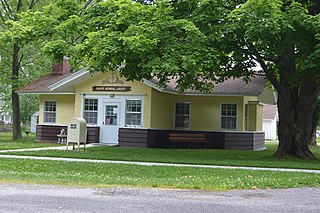
The Marine Chapter House is a historic building located on Silver Street in Marine, Illinois. The building was constructed between 1909 and 1910 as a meetinghouse for Marine's chapter of the American Woman's League. The American Woman's League was a political and social organization founded by magazine publisher Edward Gardner Lewis in 1908. The organization was created to promote feminist causes, particularly the women's suffrage movement; Lewis also intended for the organization to promote and sell his women's magazines. Lewis commissioned the St. Louis architectural firm of Helfensteller, Hirsch & Watson to design five classes of buildings which the League would use as meetinghouses. The Marine Chapter House is an example of a Class I building, which was designed for clubs with 30 to 60 members. The building was designed in the Prairie School style and cost $1,200. After the club disbanded, the building was converted to a library.

The Princeton Chapter House is a historic building located at 1009 N. Main St. in Princeton, Illinois. The building was constructed between 1909 and 1910 as a meetinghouse for Princeton's chapter of the American Woman's League. The American Woman's League was a political and social organization founded by magazine publisher Edward Gardner Lewis in 1908. The organization was created to promote feminist causes, particularly the women's suffrage movement; Lewis also intended for the organization to promote and sell his women's magazines. Lewis commissioned the St. Louis architectural firm of Helfensteller, Hirsch & Watson to design five classes of buildings which the League would use as meetinghouses. The Princeton Chapter House is the only Class IV chapter house ever built; the Class IV plan was one of the larger buildings and was designed for clubs with 140 to 200 members. The building was designed in the Mission Revival style and cost $5,000. After the club disbanded, it served as a public library before being converted to a business.
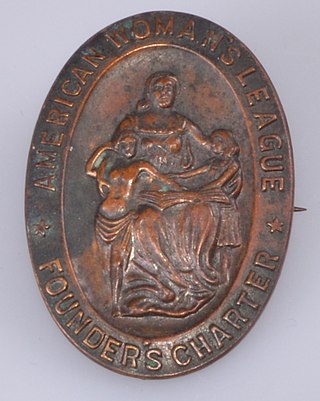
The American Woman's League was created by the magazine publisher Edward Gardner Lewis in 1907. In part, it was a maneuver to lower postal rates by appealing to educational and social opportunities that would appeal to the emerging women's suffrage movement. His magazines, Woman's Magazine and the Woman's Farm Journal, had been denied second class postal rates because they were judged as advertisements and thus did not qualify for a lower rate as second class mail. Rather than magazine sales representatives making commissions, as was the common practice at the time, the payments went to form local women's "Chapter Houses".

















